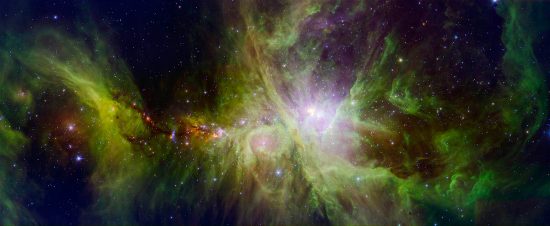
The Orion Nebula In Infrared. A combination of data from Spitzer and the Two Micron All Sky Survey (2MASS). 3.6 micron light is green and 4.5 micron light is red. 2MASS 2.5 micron light is blue. Click to enlarge.
Feb 27, 2018
Rapid fluctuations in nebular “protostars”.
Young stars in the Orion Nebula are changing in brightness faster than previously thought possible. Instead of it requiring years for gaseous envelopes surrounding so-called “proto-planetary disks” to heat up and cool down, it is happening in weeks. The information was provided by observations from the Spitzer Space Telescope.
The Spitzer Space Telescope went into an Earth-trailing orbit in 2003. Spitzer’s “cold mission” used a tank of liquid helium to keep infrared detectors at -268 Celsius. That low temperature meant that the telescope could see infrared wavelengths as long as 180,000 nanometers. For comparison, the deepest red light frequency visible to the human eye is approximately 750 nanometers. Spitzer’s helium coolant did not last, however, so it is in its “warm mission” phase, where it is still able to detect infrared signals in the 3600 to 37,000 nanometer range. This is because the ambient temperature of the instruments remains at -243 Celsius due to the cold of deep space.
In the image at the top of the page, information from Spitzer’s 8000 and 24,000 nanometer measurements are shown in green and red. The longer wavelengths, or far-infrared, indicate the warmer regions in the nebula. Is this image revealing hot spots where new stars are forming? Could another phenomenon better explain the energetic nodes and the flickering?
One possibility, not considered by contemporary astrophysicists, is that electrical oscillations are causing the relatively rapid flicker, rather than gases heating up and cooling down. It is the capacitive, resistive, and inductive electrical environment in the Orion Nebula that is causing the material to change in brightness. Plasma’s behavior is driven by conditions in cosmic electric circuits. According to Electric Universe theory, fluctuations in those circuits can form double layers in the Nebula with large potential voltages between them. Electromagnetic forces draw matter from the surrounding space into filaments. The electrical power pushes them into “glow mode”.
Electric charges in double layers are much stronger than gravitational and kinetic (thermal) forces. Double layers separate plasma into cells and filaments that can have different temperatures or densities. This can happen quickly. Astronomical theories have no mechanism that can form nebular clouds a thousand times less dense than a puff of smoke, or their energetic emissions. They do not know how matter moves through them with such velocity. The reason for that lack of understanding is that nebulae are not composed of inert gas, cold or hot, but of plasma.
Stephen Smith












